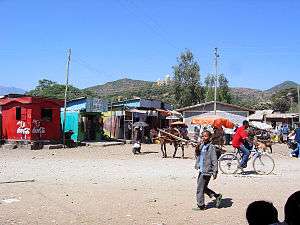Kemise
| Kemise | |
|---|---|
|
Some shops in Kemise, opposite the bus terminal | |
 Kemise Location within Ethiopia | |
| Coordinates: 10°43′N 39°52′E / 10.717°N 39.867°E | |
| Country | Ethiopia |
| Region | Amhara |
| Zone | Oromia Zone |
| Elevation | 1,424 m (4,672 ft) |
| Population (2007) | |
| • Total | 19,420 |
| Time zone | EAT (UTC+3) |
Kemise (also known as Kascim) is a town and separate woreda in north-eastern Ethiopia. The administrative center of the Oromia Zone of the Amhara Region, this town has a latitude and longitude of 10°43′N 39°52′E / 10.717°N 39.867°ECoordinates: 10°43′N 39°52′E / 10.717°N 39.867°E with an elevation of 1424 meters above sea level. It was part of former Chefe Golana Dewerahmedo woreda and is surrounded by Dawa Chefe woreda.
Overview
Around Kemise are three villages with mosques, reachable only by footpaths: Dewe Rahmedo, about 20 kilometers from Kemise; Shonke, 23 kilometers away; and about 12 kilometers south of Kemise there is a footpath to the east, after another 5 kilometers arrives at Tiru Sina. There are allegedly Muslim monasteries for men and women around this town, with their members living in round huts distributed in the landscape, separated from each other in the same way as Christian monks and nuns.[1]
On 19 January 2002 one person was killed during a clash between Muslims and Christians in Kemise. According to police reports, they arrested several persons for organizing the disruption or throwing rocks at the procession; however, all of those arrested subsequently were released. The person responsible for the death had not been identified by the year's end.[2]
Demographics
Based on the 2007 national census conducted by the Central Statistical Agency of Ethiopia (CSA), this town has a total population of 19,420, of whom 9,782 are men and 9,638 women. The majority of the inhabitants were Muslim, with 76.29% reporting that as their religion, while 21.24% of the population said they practiced Ethiopian Orthodox Christianity.[3]
The 1994 census reported this town had a total population of 10,822 of whom 5,341 were men and 5,481 women.
Notes
- ↑ "Local History in Ethiopia" The Nordic Africa Institute website (accessed 17 December 2007)
- ↑ "Ethiopia: International Religious Freedom Report 2002", Bureau of Democracy, Human Rights, and Labor, US State Department (accessed 9 July 2009)
- ↑ Census 2007 Tables: Amhara Region, Tables 2.1, 2.4, 2.5, 3.1, 3.2 and 3.4.
